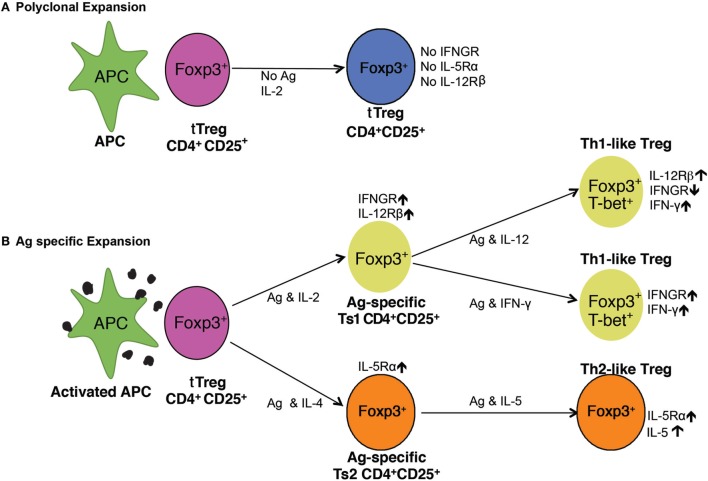Figure 7.
Pathways of activation of naïve CD4+CD25+ T regulatory cell (Treg) (tTreg). (A) Polyclonal expansion of tTreg. The most common expansion pathway of tTreg by IL-2 with non-antigen-specific stimulation leads to polyclonal expansion of tTreg, which do not express receptors for interferon (IFN)-γ, IL-5, or IL-12 and have no increased capacity to suppress. To suppress normal immune responses, tTreg are required at ratios of ≥1:1 (21, 29). (B) Antigen-specific expansion of tTreg. tTreg that have TCR for specific-alloantigen can be activated by antigen and either IL-2 or IL-4. tTreg with TCR for specific-alloantigen are activated by antigen and IL-2 to Ts1 cells, which have increased potency to suppress responses to specific-alloantigen (22). These cells are induced to express IFNGR and IL-12Rβ2 and can be further activated by either IFN-γ or IL-12 (25), in the presence of specific-alloantigen. This further activation is blocked if IL-2 is present (25). They are induced to express T-bet and IFN-γ, and are Th1-like Treg (25). These Th1-activated tTreg depend on IFN-γ or IL-12p70 as well as stimulation with specific-alloantigen for their survival and function. In the Th2 activation pathway, IL-4 and alloantigen induce Ts2 cells that express the specific receptor for IL-5Rα (22). IL-5 promotes Ts2 cells to become Th2-like Treg. IL-4 also, in the absence of antigen, induces polyclonal expansion of tTreg. These separate pathways of activation of tTreg by Th1 and Th2 cytokines explain the in vitro findings with CD4+CD25+ T cells from tolerant rats described here. The requirement of either IFN-γ or IL-5, and possibly other cytokine, for antigen-specific CD4+CD25+ Treg to survive, explains the findings that CD4+CD25+ T cells from tolerant hosts die in vitro and do not suppress unless key cytokines are present.

